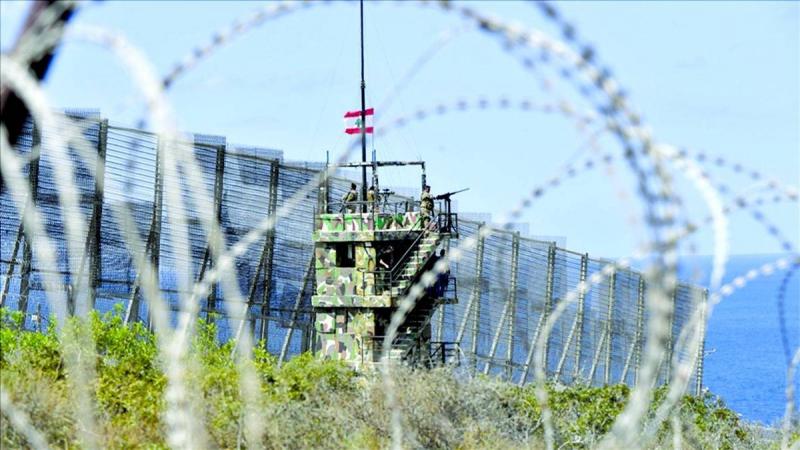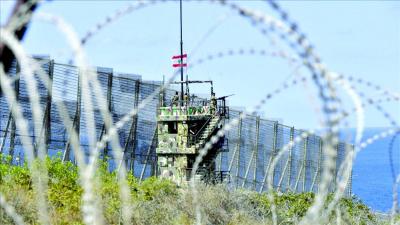At a large table in a spacious hall at one of the centers affiliated with the Islamic Resistance in southern Lebanon, sat a man in his fifties, dressed in civilian attire, waiting for a thirty-something-year-old young man to finish setting up the laptop to start the PowerPoint presentation. The calm demeanor of the fifty-year-old does not suggest that he is a senior field officer and part of a small group responsible for leading operations of the Islamic Resistance in Lebanon, overseeing a significant section of the front, which occupies a large portion of the enemy's army on the border with Lebanon, and displacing tens of thousands of settlers from the colonies in northern occupied Palestine. Meanwhile, the burgundy sports leather jacket and jeans worn by the thirty-year-old imply that he is merely a "technician" who will set up the laptop and projector and then leave.
The presentation begins with the speaker, whom I thought was just a technician, starting to "dissect" the Israeli army from the top of the hierarchy to the smallest units: names of divisions, brigades, companies, battalions, and factions, command posts, enemy troop deployments and lines, front divisions, quantities, and vehicles... to the point where you might think he resides on the other side of the border! "The initiative still rests primarily with the Resistance," the field officer confirms after 77 days of hostilities with the enemy, adding: "So far, the Resistance has used only a negligible part of what it possesses. Even the weapons we have tried very limitedly are not all types we have. We are in a stage of superiority and remain in a position of initiative; we are not obliged in the current situation to reveal all our cards."
The officer explains the often-repeated question about "the large number of martyrs among the Resistance," pointing out that "both we and the enemy's army are in constant movement, with each side changing its tactics based on battlefield developments. In the initial phase, several martyrs fell as the enemy adopted tactics that we quickly found remedies for, leading to a decrease in numbers. When they rise again, it means the enemy has found remedies for our tactics, which compels us to change them, and so on." He adds that the current state of "incomplete war we are in does not necessitate total concealment. Nevertheless, aside from some human errors, we have found remedies that led to a reduction in the number of martyrs."
The officer places the enemy's threats of waging war on Lebanon should Hezbollah not withdraw its forces from southern Litani into the context of "psychological warfare and an attempt to contain the anger of residents in northern colonies. Of course, we are ready for that, but in military science and logic, it is impossible for the enemy to open two fronts simultaneously. It is true that the element of surprise has been lost, but this applies to us as well as to the enemy. We are also learning lessons from what is happening in Gaza. If the bet is on the enemy's firepower and destructive capabilities, they are aware of the extent of the destructive capabilities of the Resistance's weaponry. Therefore, the states of the front are weighed with a balance of gold in a moving front and under moving rules of engagement."
Additionally, the field officer states that the data about the nature of the Israeli army formations on the border indicates a defensive posture of infantry, armored units, intelligence, and artillery positions, despite new divisions of operational areas, reinforcements, and more than three military divisions, amounting to about 50,000 soldiers on the other side of the border. He indicates that part of this deployment aims to compensate for the repercussions of what the so-called enemy's electronic flies termed "the war of columns" (the targeting of Resistance systems for radar and surveillance along the border). The enemy had previously established one of the strongest defensive lines in the world in terms of land and aerial intelligence, alongside a concrete wall and a technical fence with a wireless detection system. This line has suffered "total blindness" since the outbreak of hostilities, prompting the enemy, which once relied on these arrangements to avoid human proximity to the border, to attempt to replace it by deploying three defensive lines: the first near the front-edge sites and border settlements, the second about two kilometers deep around the settlements, and the third at a depth of seven kilometers. They were also forced to resort to new tactics, such as unprecedented reliance on civilian vehicles and continuous targeting of the edge areas, as well as preemptive strikes on regions that could be used to fire at their forces, and human intelligence efforts monitoring the edge at all times, accompanied by an exaggerated media campaign emphasizing the need to change the previous state of affairs.
The field officer emphasizes that "the magnitude of the enemy's loss in terms of information gathering is greater than that of the Resistance, which was able, in two weeks, to recover 95% of its informational and intelligence status as it was before the war. Furthermore, reconnaissance from our side with drones over enemy territory continues uninterrupted, with many drones going and returning without the enemy managing to shoot them down."
Returning to the "war of columns," the source in the Resistance points out that what we are dealing with is not surveillance cameras like those used in buildings and shops, but rather a "complete surveillance and intelligence system with radar networks and antennas, each costing hundreds of thousands of dollars. The most important aspect is the intelligence benefits that these systems provide for the enemy." This involves close monitoring of the entire southern area, extending at least ten kilometers deep, knowing that some of these systems have a range of up to 35 kilometers with high-quality coverage; others function as "integrated intelligence devices," capable of collecting, cross-referencing, and connecting information to draw conclusions and achieve breakthroughs, including recruiting agents. The source notes that some of these sites hold strategic importance related to military and intelligence operations at a regional level, extending to Syria, Iraq, and potentially farther. Among the most notable sites is Jall al-Amal, which contains advanced antenna devices, a jamming system against drones, a thermal imaging system with a view range of several tens of kilometers, and long-range target aerial radar.




